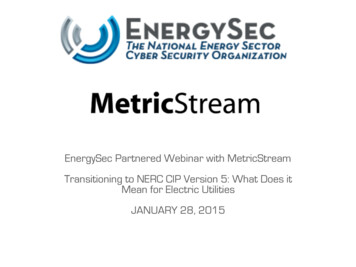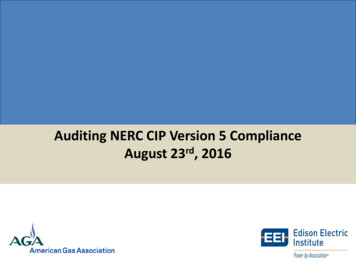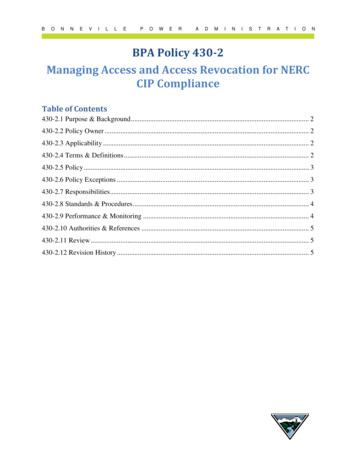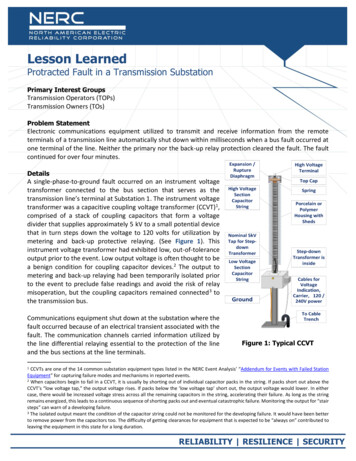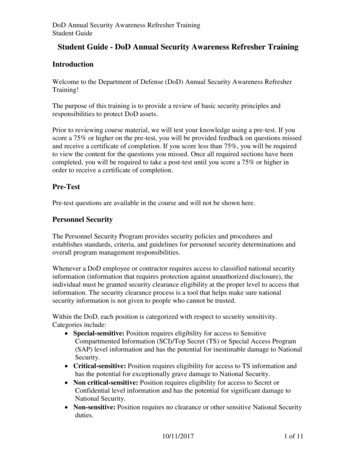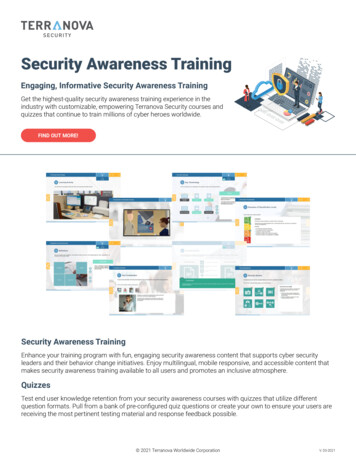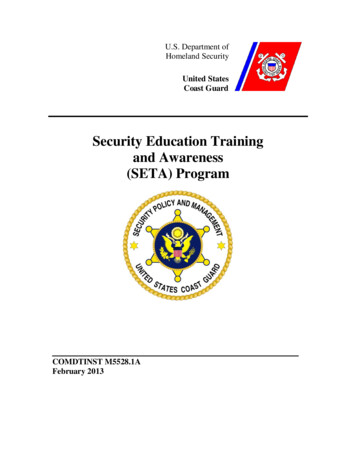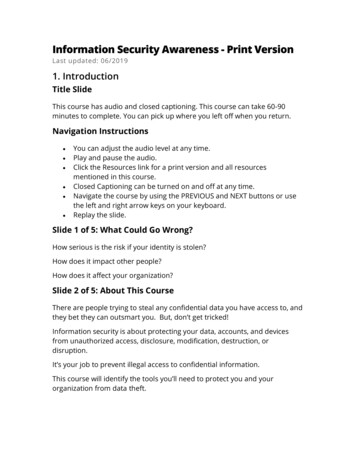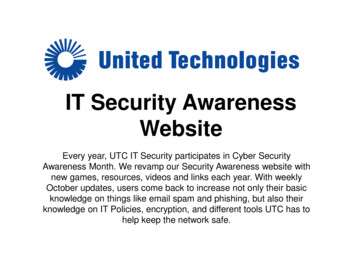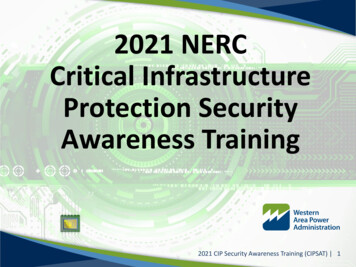
Transcription
2021 NERCCritical InfrastructureProtection SecurityAwareness Training2021 CIP Security Awareness Training (CIPSAT) 1
Applicability All WAPA Federal and Contract employeesare required to complete annual NorthAmerican Electric Reliability Corporation(NERC) Critical Infrastructure Protection(CIP) security awareness training2021 CIP Security Awareness Training (CIPSAT) 2
Contents: CIP Security Awareness Training (CIPSAT)Topic PageNERC Critical Infrastructure Protection training introductionKey TermsCyber Security PoliciesPhysical Access ControlsElectronic Access ControlsVisitor Control ProgramHandling of BES Information and Its StorageIncident identification and notificationRecovery PlansResponse to Cyber Security IncidentsRisks associated with interconnectivityInformation Protection and BCSIChange Control and Configuration ManagementTransient Cyber Assets and Removable MediaAdditional TrainingAddendum: Resources and 829-3031322021 CIP Security Awareness Training (CIPSAT) 3
NERC CIP training requirements All WAPA Employees (federal and contractor) mustcomplete annual CIP Security Awareness Training (CIPSAT)which is comprised of these slides. WAPA will also provide, at least once each calendarquarter, awareness training that reinforces cyber securitypractices for WAPA personnel who have authorizedelectronic/logical or authorized unescorted physical accessto Bulk Electric System (BES) Cyber Systems. This quarterlyawareness training may consist of WAPA publications,email, posters, and presentations.2021 CIP Security Awareness Training (CIPSAT) 4
NERC CIP training requirements (cont.)Included in this CIP Security Awareness Training are the following topics:1.Cyber security policies2.Physical access controls3.Electronic access controls4.The visitor control program5.Handling of BES Cyber System Information and its storage6.Identification of a Cyber Security Incident and initial notifications in accordance withthe entity’s incident response plan7.Recovery plans for BES Cyber Systems8.Response to Cyber Security Incidents9.Cyber security risks associated with a BES Cyber System’s electronicinterconnectivity and interoperability with other Cyber Assets, including TransientCyber Assets, and with Removable Media.2021 CIP Security Awareness Training (CIPSAT) 5
NERC CIP training requirements (cont.)Completion of CIP Security Awareness Training (CIPSAT) isrequired prior to granting authorized electronic/logicalaccess and authorized unescorted physical access toapplicable Cyber Assets, except during CIP ExceptionalCircumstances.This training is also required for informational access,unless handling requirements are covered by other legalmeans (such as a non-disclosure agreement).2021 CIP Security Awareness Training (CIPSAT) 6
Additional training goalsEnsure employees: Understand physical and electronic/logicalaccess controls to prevent NERC violationsand protect BES Cyber Assets Properly handle and control information Develop awareness of the “rules ofbehavior” unique to accessing, operating,changing, and maintaining BES Cyber Assets2021 CIP Security Awareness Training (CIPSAT) 7
Key termsThe following terms may be referenced in this training and are important to understand forgeneral CIP Security Awareness. Bulk Electric System (BES): As defined by the Regional Reliability Organization, theelectrical generation resources, transmission lines, interconnections with neighboringsystems, and associated equipment, generally operated at voltages of 100 kV or higher.Radial transmission facilities serving only load with one transmission source aregenerally not included in this definition.BES Cyber System: One or more BES Cyber Assets logically grouped by a responsibleentity to perform one or more reliability tasks for a functional entity.BES Cyber Assets: A Cyber Asset that if rendered unavailable, degraded, or misusedwould, within 15 minutes of its required operation, mis-operation, or non‐operation,adversely impact one or more Facilities, systems, or equipment, which, if destroyed,degraded, or otherwise rendered unavailable when needed, would affect the reliableoperation of the Bulk Electric System. Redundancy of affected Facilities, systems, andequipment shall not be considered when determining adverse impact. Each BES CyberAsset is included in one or more BES Cyber SystemsMore information and additional terms may be referenced on the NERC web site. A link isprovided in the Addendum: Resources and Links, located at the end of this training.2021 CIP Security Awareness Training (CIPSAT) 8
Key terms (cont.) Critical Assets: Facilities, systems, and equipment which, if destroyed, degraded, orotherwise rendered unavailable, would affect the reliability or operability of the BulkElectric SystemCyber Assets: Programmable electronic devices and communication networks includinghardware, software, and data.Transient Cyber Assets: A Cyber Asset that (i) is capable of transmitting or transferringexecutable code, (ii) is not included in a BES Cyber System, (iii) is not a Protected CyberAsset (PCA), and (iv) is directly connected (e.g., using Ethernet, serial, Universal SerialBus, or wireless, including near field or Bluetooth communication) for 30 consecutivecalendar days or less to a BES Cyber Asset, a network within an ESP containing high ormedium impact BES cyber systems, or a PCA. Examples include, but are not limited to,Cyber Assets used for data transfer, vulnerability assessment, maintenance, ortroubleshooting purposes.Protected Cyber Asset (PCA)Physical Access Control System (PACS)Electronic Access Control and Monitoring (EACM)2021 CIP Security Awareness Training (CIPSAT) 9
CIP Security Awareness Training Content:1) Cyber security policiesFederal and contract employees with authorized logical access and/orauthorized unescorted physical access to a BES Facility or BES CyberAsset must be familiar with: WAPA Rules of Behavior WAPA Policy 205.2F Cyber Security and Security Management WAPA Order 470.1I Safeguards and Security Program WAPA Order 471.3A Information Control2021 CIP Security Awareness Training (CIPSAT) 10
CIP Security Awareness Training Content:2) Physical access controlsPhysical CIP Access:1. All BES Cyber Systems are contained within a Physical Security Perimeter (PSP).2. Only personnel with current authorization may enter the PSP without an escort.Never loan/share your badge or key with another individual. Report a lost orstolen badge or key immediately.3. Tailgating (following, or allowing someone to follow) is prohibited, as NERC CIPrequires that each individual be logged when passing through a PSP.4. Authorized physical access to a PSP is controlled and monitored by means of anelectronic Physical Access Control System (PACS). The PAC will grant access atmedium impact facilities using a badge only. Access at a high impact facility willrequire both a badge and PIN.5. The PACS or a lock will grant access at low impact facilities. (refer to next slide)2021 CIP Security Awareness Training (CIPSAT) 11
CIP Security Awareness Training Content:Physical access controls (cont.)Physical Security is afforded to all WAPA Low Impact BES Cyber Systems and physicalaccess is based on need. At a minimum, the physical security afforded shall includeat least one of the following, as deemed most appropriate by WAPA: The BES Cyber System is located within a locked building when not attended. The BES Cyber System is located within a building with entrances which arealarmed through a PACS system. The BES Cyber System is located within a building with entrances which arealarmed through a SCADA system. The BES Cyber System is located within a locked cabinet.2021 CIP Security Awareness Training (CIPSAT) 12
CIP Security Awareness Training Content:Physical access controls (cont.)Physical CIP Access – Any Facility: In the event of a badge failure the individual requiring access must contact theSecurity Operations Center (SOC) with their name and assigned PACS PIN. The onduty Officer will confirm access is authorized in the PACS, and verify thename/PACS PIN combination is correct before granting access remotely over thePACS. Personnel shall contact the on-duty Officer when departing. In the event of a PACS system failure, a mechanical key-override process isinstituted. Individuals requiring access to an override key must contact the SOCand verify identity by stating name and PIN. The on-duty Officer confirms access isauthorized in the PACS and verifies that the name/PIN combination is correctbefore disclosing the key box combination. For additional information, contact your regional OSEM representative.2021 CIP Security Awareness Training (CIPSAT) 13
CIP Security Awareness Training Content:3) Electronic/Logical access controlsElectronic CIP Access: NERC CIP Standards require that all logical access be logged when passing through a “ElectronicSecurity Perimeter” when using a user ID and password Logical (electronic) access records must be kept at least 90 days. Logs must be kept longer if related to a reportable incident.Unless exempted in writing: DO NOT connect an outside digital device (transient cyber asset or removable media) to any assetwithin the electronic security perimeter. This includes devices such as: USB/thumb drives, CD/DVD,mobile phones, and laptops. Approval for use of these devices must be obtained in writing by theresponsible manager and should be assessed for risk by Cyber Security. DO NOT download software of any type or add or remove assets unless approved via the CIP ChangeManagement Process. DO NOT Use a BES Cyber Asset for personal use. These assets are for business mission use only.Laptops may connect to the WAPA GSS network for updates to anti-virus, Operating System, Applications,or other approved changes and then connect to CIP Low, Medium and High impact sites.2021 CIP Security Awareness Training (CIPSAT) 14
CIP Security Awareness Training Content:4) The visitor control programVisitor Controls - When escorting visitors within a CIP Physical Security Perimeter (PSP) it isyour responsibility to: Understand that only those people with current authorization to enter the PSP can escortvisitors or other unauthorized individuals into the PSP. Continually escort any individual who does not have authorized, unescorted access. Enter the area before the escorted person and leave the area after the escorted person. Maintain continuous line of sight or dedicated focus of the unauthorized person(s) Limit the visitors to no more than five per escort and keep in close proximity Conduct a proper handoff of escorting duties if you need to depart the area. Thishandoff must include: Ensuring the new escort has authorized, unescorted privileges within the PSP Briefing the escort on the visitors present, including names, orgs, purpose forentering the PSP, time entered, and how access into the PSP was logged Verbal confirmation from the new escort that they understand they are assumingall escorting responsibilities and understand what those responsibilities entail Notifying the visitors present of who is the new escort2021 CIP Security Awareness Training (CIPSAT) 15
CIP Security Awareness Training Content:4) The visitor control program (cont.)Visitor Controls - When escorting visitors it is your responsibility to: Know the logging procedures your Region uses and log all visitors into a PSP Visitors must either sign the associated CIP area visitor log or call the associatedSOC who records visitor information on a Daily Activity Report (DAR). Recorded visitor information includes date and time of the initial entry and last exit,visitor name, and name of responsible host.It is the responsibility of the escort to ensure that visitors complete all fields listed inthe visitor log or all visitor information is reported to the SOC. Ensure no visitor harms the integrity of the critical cyber assets or interfereswith the reliability of the Bulk Electric System.NOTE: CIP area Visitor Logs and DARs are collected and reviewed quarterly.2021 CIP Security Awareness Training (CIPSAT) 16
CIP Security Awareness Training Content:5) Handling of BES Cyber System Information(BCSI) and its storageBCSI Protection:Users are responsible for protecting BCSI from unauthorized access.Users will not attempt to access any BCSI or programs contained on anysystem for which they do not have authorization or explicit consent of theowner of the system.Before sharing BSCI, verify that those you share with have accessauthorization to that information.2021 CIP Security Awareness Training (CIPSAT) 17
CIP Security Awareness Training Content:5) Handling of BES Cyber System Information(BCSI) and its storage (cont.)Additional practices to follow to protect BCSI: Lock the workstation before you leave. Encrypt Official Use Only (OUO) and Personally Identifiable Information (PII)for electronic storage and/or transmission. Protect media from adverse environmental conditions, such as heat andmagnetic fields that can cause damage. Handle and process Engineering information as per WAPA O 471.3A(Information Control Order) BES Cyber System Information contained on Transient Cyber Assets must beproperly managed per WAPA policy and procedures. (Refer to the topics forTransient Cyber Assets, and Information Protection elsewhere in thistraining)2021 CIP Security Awareness Training (CIPSAT) 18
CIP Security Awareness Training Content:6) Identification of a Cyber Security Incident andinitial notifications in accordance with the entity’sincident response planBe aware of how to identify incidents, as identified in the WAPA Cyber Security IncidentResponse Plan (CSIRP).Report suspected cyber security incidents immediately to WITCC or your Information SystemSecurity Officer (ISSO).Incident identification and detection is described in WAPA’s Cyber Security Incident ResponsePlan (CSIRP):“An incident is a violation or the threat of a violation of information security policies,acceptable use policies and/or other security policies. Examples of incidents include a Denial ofService (DoS) to a WAPA’s web page, download and installation of malware through email or aweb page, WAPA data loss not released through approved agency methods, the disclosure orcompromise of WAPA credentials into a web site not managed by WAPA, or an unplanneddisruption or the attempt of disruption to the BES by unauthorized personnel through a cybersecurity control. “Reference: WAPA Cyber Security Incident Response Plan (CSIRP).2021 CIP Security Awareness Training (CIPSAT) 19
CIP Security Awareness Training Content:7) Recovery Plans for BES Cyber Systems Become familiar with the Recovery Plan for the assets in your area.Know the roles you may be assigned for Recovery activity.Ensure that Recovery Plans are exercised periodically, at least annually.Be familiar with any backup and restore procedures for assets in yourarea. Backup and recovery of assets must be tested periodically, as defined intheir recovery plan. Identify any lessons learned that are determined from Recovery tests,exercises, or real recovery activities. Update recovery plans to reflect lessons learned from recovery tests,exercises, or actual recoveries. Notify those with roles in the recovery plan of the update to the plan.2021 CIP Security Awareness Training (CIPSAT) 20
CIP Security Awareness Training Content:8) Response to Cyber Security IncidentsReporting Incidents:Employees will report all incidents or attempts of anyone trying to gainunauthorized access to BES Cyber Assets or other computer resources to theproper authorities by contacting the WAPA IT Call Center (720-962-7111), yourCyber Security Officer, or your IT Manager.Reference: WAPA Cyber Security Incident Response Plan (CSIRP).2021 CIP Security Awareness Training (CIPSAT) 21
CIP Security Awareness Training Content:9) Cyber security risks associated with a BES CyberSystem’s electronic interconnectivity andinteroperability with other Cyber Assets, includingTransient Cyber Assets, and with Removable Media.Know the risks associated with systems interconnectivity: Risks associated with exposing connections outside the boundary, leading to loss ofconfidentiality, integrity, and availability.Know the risks associated with transient cyber assets and removable media: Risk from exposure to malware. Risks associated with loss or theft. Risks associated with unencrypted information, leading to loss of confidentiality. Risks associated with moving cyber assets such as removable media from a lowsecurity enclave to a higher security enclave (and vice versa).2021 CIP Security Awareness Training (CIPSAT) 22
CIP Security Awareness Training Content:9) Cyber security risks associated with a BES CyberSystem’s electronic interconnectivity andinteroperability with other Cyber Assets, includingTransient Cyber Assets, and with Removable Media.(cont.)Any new BES Cyber System connections must be formally reviewed and approved byCyber Security personnel and/or managers of those systems via the appropriateChange Control and Configuration Management Processes.Changes to existing BES Cyber System connections must be formally reviewed andapproved by Cyber Security personnel and/or managers of those systems via theappropriate Change Control and Configuration Management Processes .2021 CIP Security Awareness Training (CIPSAT) 23
Information Protection and BCSI Information Protection Officers (IPOs) will manage classification and categorizationdecisions for information – only these IPOs can designate information as BES CyberSystem Information, or “BCSI”. The IPOs are members of the IT Cyber SecurityInformation Assurance Group (refer to points of contact on slide 81) and the ITCybersecurity Compliance Support Group.Physical protection of OUO, including BCSI, is required in unmanned facilities, such assubstations.Follow best practices in your office – lock computer, file or put away paper.Encrypt BCSI and other OUO information whenever technically feasible, both data atrest (files) and data in transit (email).Mobile device require additional protection. A signed user agreement (currently underdevelopment) will be required for personal phones as well as work phones accessingWAPA information including email.Become familiar with best practices for media sanitization and destruction of disposedassets containing information as described in WAPA O 471.3A.Consult with your Information Cyber Security Officer (ISSO) for additional information.Reference WAPA’s Information Control Order WAPA O 471.3A.2021 CIP Security Awareness Training (CIPSAT) 24
BSCI updatesApproved locations and procedures Approved Systems designated for storing BCSI: Maximo - Asset Management SystemEngineering Design Drive – Access Controlled CIP File StorageCybersecurity Compliance Support SharePoint Site:https://compliance.wapa.intASPEN Relay Database To get access, your supervisor must request yourentitlements to these sites using WAYS (whereyou can filter available roles using “CIP”)2021 CIP Security Awareness Training (CIPSAT) 25
BSCI updatesApproved locations and procedures (cont.) Example WAYS BCSI Related Access Entitlements: CIP Aspen CIP Maximo CIP SharePoint insert specific library names CIP Engineering Drawings insert region WAYS requires your supervisor to include a statement ofyour need for access with the request.Access authorization should be verified before sharing BCSI.2021 CIP Security Awareness Training (CIPSAT) 26
Change Control and ConfigurationManagement Additions or Changes to BES Cyber Systems must go through the ConfigurationChange Management Process The Change Control Process includes cyber security testing and baselinemanagement The Change Control Pr
Contents: CIP Security Awareness Training (CIPSAT) NERC Critical Infrastructure Protection training introduction 4-7 Key Terms 8-9 Cyber Security Policies 10 Physical Access Controls 11-13 Electronic Access Controls 14 Visitor Control Program 15-16 Handling of BES Information and Its St
